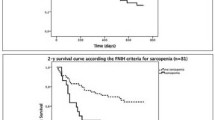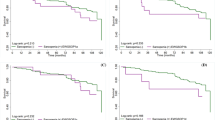Abstract
Background
Sarcopenia is a progressive loss of muscle mass, strength, and function. It is linked to functional decline, and secondary to this, to nursing home admission.
Aims
To look into the prevalence of sarcopenia in a nursing home population and to gain insight into the relation of sarcopenia with mortality in this cohort.
Methods
A longitudinal cohort follow-up started in October 2007 in 52 nursing homes in Belgium. Following data were procured: anthropometrics (weight/length), body composition (muscle mass through bio-impedance absorptiometry, BIA), functional status (Katz), nutritional status (mini-nutritional assessment-short form, MNA), and a number of laboratory parameters.
Results
In total, 745 residents were included. Mean age was 84.6 ± 7.2 years. Mean follow-up time was 1632 ± 1026 days. In total, 17% had severe sarcopenia, 45% had moderate sarcopenia, and 38% had no sarcopenia. Following items were significant (p < 0.05) on univariate analysis with mortality as outcome: sarcopenia, gender, BMI, skeletal muscle mass, age, MNA, and functional level. In multivariate analysis, only MNA, skeletal muscle mass, and age were still significant. Odds ratio for skeletal muscle mass was 1.171 for the highest percentile group, 2.277 for the middle percentile group, and 4.842 for the lowest percentile group.
Discussion
The prevalence of sarcopenia was higher than in comparative literature, for which there are a few hypotheses. Cut-off values for sarcopenia using BIA for specific cohorts need to be re-evaluated.
Conclusions
It seems to remain useful to screen for muscle mass in institutionalized elderly, because there is a clear and significant correlation with long-term mortality.



Similar content being viewed by others
References
Beaudart C, Zaaria M, Pasleau F et al (2017) Health outcomes of sarcopenia: a systematic review and meta-analysis. PLoS One 12:e0169548
Ethgen O, Beaudart C, Buckinx F et al (2017) The future prevalence of sarcopenia in Europe: a claim for public health action. Calcif Tissue Int 100:229. https://doi.org/10.1007/s00223-016-0220-9
Batsis JA, Barre LK, Mackenzie TA et al (2013) Variation in the prevalence of sarcopenia and sarcopenic obesity in older adults associated with different research definitions: dual-energy X-ray absorptiometry data from the National Health and Nutrition Examination Survey 1999–2004. J Am Geriatr Soc 61:974–980
Beaudart C, Reginster JY, Slomian J et al (2015) Estimation of sarcopenia prevalence using various assessment tools. Exp Gerontol 61:31–37
Beaudart C, Rizzoli R, Bruyere O et al (2014) Sarcopenia: burden and challenges for public health. Arch Public Health 72:45
Cruz-Jentoft AJ, Landi F, Schneider SM et al (2014) Prevalence of and interventions for sarcopenia in ageing adults: a systematic review. Report of the International Sarcopenia Initiative (EWGSOP and IWGS). Age Ageing 43:748–759
Senior HE, Henwood TR, Beller EM et al (2015) Prevalence and risk factors of sarcopenia among adults living in nursing homes. Maturitas 82:418–423
Zeng Y, Hu X, Xie L et al (2018) The prevalence of sarcopenia in Chinese elderly nursing home residents: a comparison of 4 diagnostic criteria. J Am Med Dir Assoc 19:690–695
Luppa M, Luck T, Weyerer S et al (2010) Prediction of institutionalization in the elderly. A systematic review. Age Ageing 39:31–38
Brown RT, Diaz-Ramirez LG, Boscardin WJ et al (2017) Functional impairment and decline in middle age: a cohort study. Ann Intern Med 167:761–768
Auyeung TW, Kwok T, Lee J et al (2008) Functional decline in cognitive impairment—the relationship between physical and cognitive function. Neuroepidemiology 31:167–173
Bautmans I, Van Puyvelde K, Mets T (2009) Sarcopenia and functional decline: pathophysiology, prevention and therapy. Acta Clin Belg 64:303–316
Tanimoto Y, Watanabe M, Sun W et al (2013) Association of sarcopenia with functional decline in community-dwelling elderly subjects in Japan. Geriatr Gerontol Int 13:958–963
Janssen I, Baumgartner RN, Ross R et al (2004) Skeletal muscle cutpoints associated with elevated physical disability risk in older men and women. Am J Epidemiol 159:413–421
Wang SY, Shamliyan TA, Talley KM et al (2013) Not just specific diseases: systematic review of the association of geriatric syndromes with hospitalization or nursing home admission. Arch Gerontol Geriatr 57:16–26
Landi F, Liperoti R, Fusco D et al (2012) Sarcopenia and mortality among older nursing home residents. J Am Med Dir Assoc 13:121–126
Van Puyenbroeck K, Roelandts L, Van Deun T et al (2012) The additional value of bioelectrical impedance analysis-derived muscle mass as a screening tool in geriatric assessment for fall prevention. Gerontology 58:407–412
Janssen I, Heymsfield SB, Baumgartner RN et al (2000) Estimation of skeletal muscle mass by bioelectrical impedance analysis. J Appl Physiol (1985) 89:465–471
Janssen I, Heymsfield SB, Ross R (2002) Low relative skeletal muscle mass (sarcopenia) in older persons is associated with functional impairment and physical disability. J Am Geriatr Soc 50:889–896
Cruz-Jentoft AJ, Baeyens JP, Bauer JM et al (2010) Sarcopenia: European consensus on definition and diagnosis: report of the European Working Group on Sarcopenia in Older People. Age Ageing 39:412–423
Podsiadlo D, Richardson S (1991) The timed “Up & Go”: a test of basic functional mobility for frail elderly persons. J Am Geriatr Soc 39:142–148
Kaiser MJ, Bauer JM, Ramsch C et al (2009) Validation of the Mini Nutritional Assessment short-form (MNA-SF): a practical tool for identification of nutritional status. J Nutr Health Aging 13:782–788
Janssen I, Heymsfield SB, Wang ZM et al (2000) Skeletal muscle mass and distribution in 468 men and women aged 18–88 year. J Appl Physiol (1985) 89:81–88
Tay L, Ding YY, Leung BP et al (2015) Sex-specific differences in risk factors for sarcopenia amongst community-dwelling older adults. Age (Dordr) 37:121
Ziai S, Coriati A, Chabot K et al (2014) Agreement of bioelectric impedance analysis and dual-energy X-ray absorptiometry for body composition evaluation in adults with cystic fibrosis. J Cyst Fibros 13:585–588
Savastano S, Belfiore A, Di Somma C et al (2010) Validity of bioelectrical impedance analysis to estimate body composition changes after bariatric surgery in premenopausal morbidly women. Obes Surg 20:332–339
Kim M, Kim H (2013) Accuracy of segmental multi-frequency bioelectrical impedance analysis for assessing whole-body and appendicular fat mass and lean soft tissue mass in frail women aged 75 years and older. Eur J Clin Nutr 67:395–400
Scafoglieri A, Clarys JP, Bauer JM et al (2017) Predicting appendicular lean and fat mass with bioelectrical impedance analysis in older adults with physical function decline—the PROVIDE study. Clin Nutr 36:869–875
Raimann JG, Abbas SR, Liu L et al (2014) Agreement of single- and multi-frequency bioimpedance measurements in hemodialysis patients: an ancillary study of the Frequent Hemodialysis Network Daily Trial. Nephron Clin Pract 128:115–126
Lima-Costa MF, Peixoto SV, Matos DL et al (2011) Predictors of 10-year mortality in a population of community-dwelling Brazilian elderly: the Bambui Cohort Study of Aging. Cad Saude Publica 27:S360–S369
Kojima G, Iliffe S, Walters K (2018) Frailty index as a predictor of mortality: a systematic review and meta-analysis. Age Ageing 47:193–200
Correia MI, Waitzberg DL (2003) The impact of malnutrition on morbidity, mortality, length of hospital stay and costs evaluated through a multivariate model analysis. Clin Nutr 22:235–239
Ulger Z, Halil M, Cankurtaran M et al (2013) Malnutrition in Turkish nursing homes: a correlate of short term mortality. J Nutr Health Aging 17:305–309
Lilamand M, Kelaiditi E, Demougeot L et al (2015) The mini nutritional assessment-short form and mortality in nursing home residents–results from the INCUR study. J Nutr Health Aging 19:383–388
Szulc P, Munoz F, Marchand F et al (2010) Rapid loss of appendicular skeletal muscle mass is associated with higher all-cause mortality in older men: the prospective MINOS study. Am J Clin Nutr 91:1227–1236
Arango-Lopera VE, Arroyo P, Gutierrez-Robledo LM et al (2013) Mortality as an adverse outcome of sarcopenia. J Nutr Health Aging 17:259–262
Mosekilde L (2005) Vitamin D and the elderly. Clin Endocrinol (Oxf) 62:265–281
Lips P, Duong T, Oleksik A et al (2001) A global study of vitamin D status and parathyroid function in postmenopausal women with osteoporosis: baseline data from the multiple outcomes of raloxifene evaluation clinical trial. J Clin Endocrinol Metab 86:1212–1221
Lips P (2007) Vitamin D status and nutrition in Europe and Asia. J Steroid Biochem Mol Biol 103:620–625
Acknowledgements
No funds were received for this study. The authors would like to thank the administrative departments of the different districts of Antwerp in aiding in the collection of data.
Author information
Authors and Affiliations
Contributions
SP and VV conceived and designed the study; SP and VV collected and analysed the data; SP wrote the paper; MV, AMDC, and VV revised the manuscript.
Corresponding author
Ethics declarations
Conflict of interest
The authors declare no conflict of interest.
Ethical approval
Ethical approval for this study has been granted by the University of Antwerp’s Medical Research ethics committee, for both parts of the study.
Informed consent
All included patients gave informed consent, which was noted down in the patient files.
Rights and permissions
About this article
Cite this article
Perkisas, S., De Cock, AM., Vandewoude, M. et al. Prevalence of sarcopenia and 9-year mortality in nursing home residents. Aging Clin Exp Res 31, 951–959 (2019). https://doi.org/10.1007/s40520-018-1038-2
Received:
Accepted:
Published:
Issue Date:
DOI: https://doi.org/10.1007/s40520-018-1038-2




